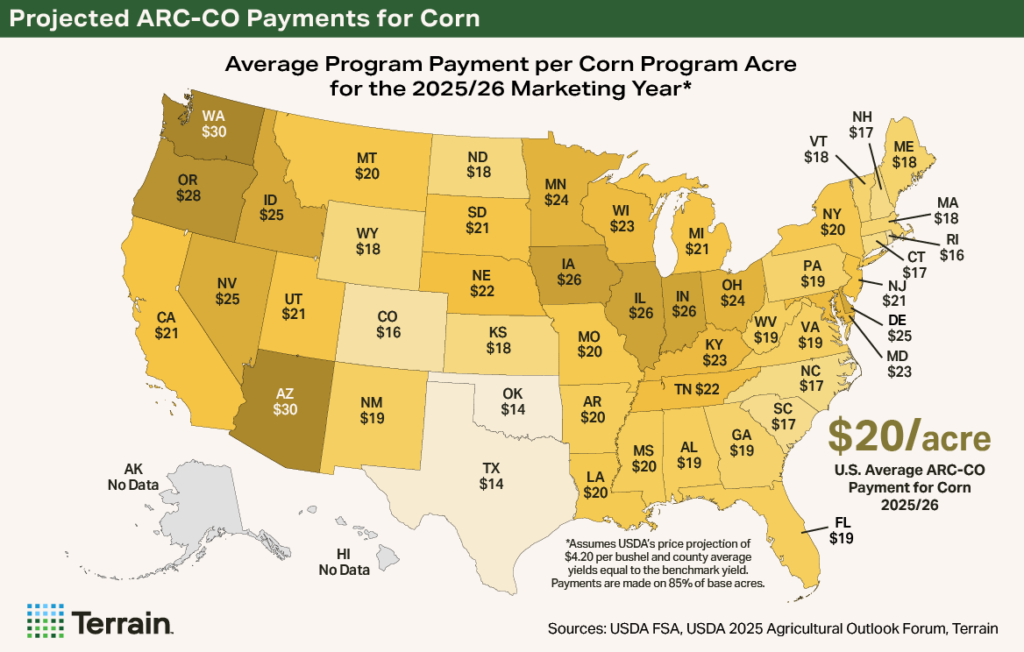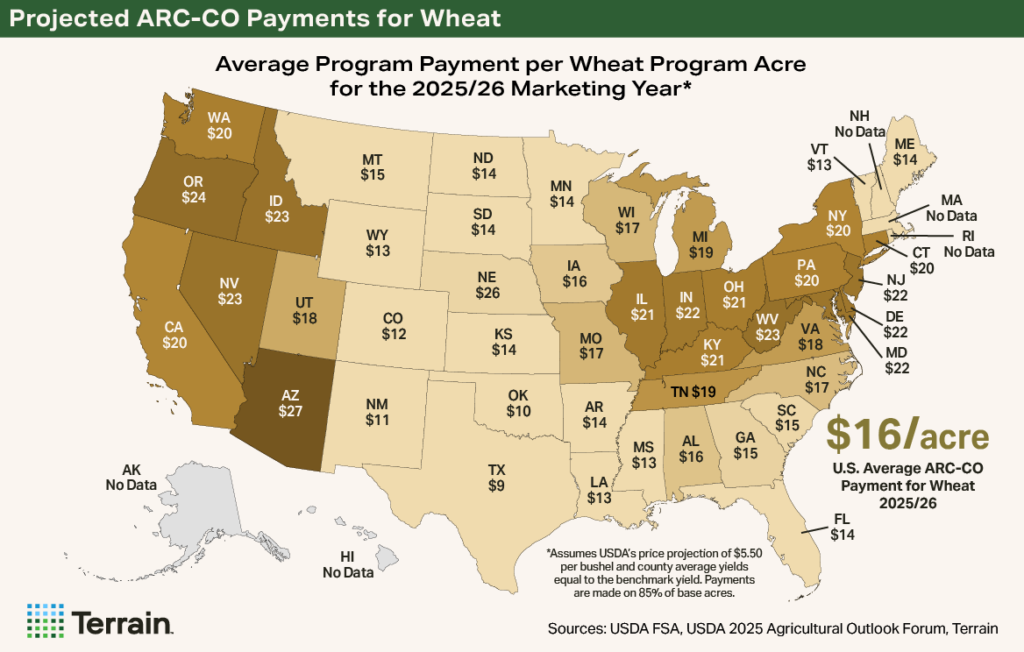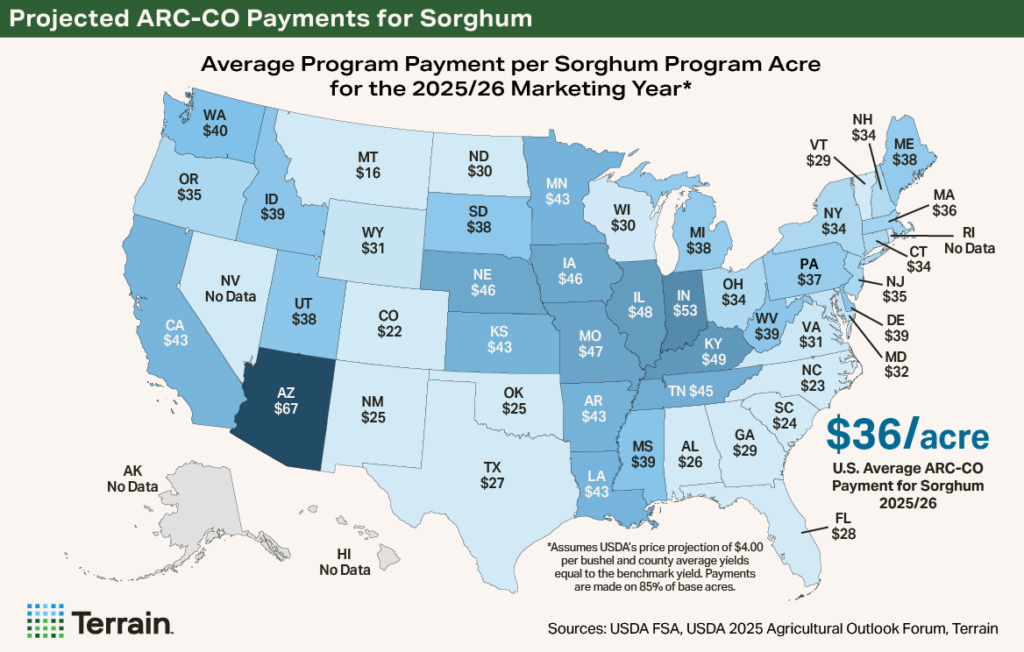With spring crop insurance decisions behind farmers, all eyes next turn to the April 15 deadline for enrollment in Agriculture Risk Coverage (ARC) and Price Loss Coverage (PLC).
Support levels for some crops will reach levels at or near their historic highs. For example, the price components of ARC benchmark guarantees for corn and soybeans for the 2025 crop year are $5.03/bu. and $12.17/bu., respectively — their highest levels in nearly a decade. Read more at ARC and PLC to Offer Higher Support (for Some) in 2025.
Given the higher level of support and the upcoming enrollment deadline, farmers are now considering the expected benefits associated with enrolling in ARC or PLC on a commodity-by-commodity basis. Recall that ARC provides support against county-level revenue declines and PLC provides support against crop price declines.
To provide some insight into the risk management benefits of each program, I used price projections from the USDA’s 2025 Agricultural Outlook Forum for new-crop corn, soybeans, wheat and sorghum to estimate potential program payments for both ARC and PLC.i
Evaluating ARC and PLC for 2025/26
The USDA’s updated price projections for the crop marketing year show new-crop corn prices dropping 15 cents from last year’s average price to $4.20/bu., soybeans declining 10 cents to $10/bu., wheat declining 5 cents to $5.50/bu., and sorghum declining 25 cents to $4/bu.
In all cases except soybeans, the projected new-crop price is below the PLC effective reference price guarantee. In the case of ARC, price declines for these major crops are large enough (greater than 14%) to trigger ARC program payments (holding yields constant).


Given current price projections, and holding yield risk constant:
- For corn, ARC is projected to result in a program payment of 13 cents/bu. and PLC is projected to pay 6 cents/bu.;
- For soybeans, ARC program payments are projected at 47 cents/bu. and no PLC payments are expected (prices would need to fall by more than 34 cents/bu. from current projections to result in a PLC payment);
- For wheat, a 28 cents/bu. program payment is projected for ARC and a 6 cents/bu. payment is projected for PLC; and
- For sorghum, projected ARC and PLC payments are 56 cents/bu. and 51 cents/bu., respectively.
Under the current price forecast for 2025/26, ARC is largely expected to outperform PLC for corn, soybeans and wheat, holding yields constant. For sorghum, ARC and PLC benefits are not materially different.
Yield Histories Matter
Yield histories matter when comparing ARC and PLC. ARC is largely expected to outperform PLC for major crops such as corn, soybeans and wheat. However, in counties that have experienced significant yield declines due to drought or other weather events over multiple years (for example, in western Kansas, Oklahoma or Texas), there may be a “yield drag” where the benchmark yield is lower than the county’s “normal” productivity. For example, the yield variability for corn from 2019 to 2023 (the years used to determine the Olympic moving average) were highest in areas that have experienced significant drought conditions during those years.
In these cases, a return to “normal” yields may more than offset any price-related revenue declines in ARC, reducing or potentially eliminating a program payment.
If farmers purchased the USDA’s Supplemental Coverage Option (SCO) crop insurance, they can bundle SCO with PLC for better revenue protection and protection against lower crop prices.
State-Level Benefits of ARC
Using the USDA’s data on 2025 ARC-County Benchmark Yields and Revenues as of February 10, 2025, and its most recent price projections (while holding yields unchanged), it is possible to provide early insight into potential state-level average ARC benefits for corn, soybeans, wheat and sorghum. In all cases, projected ARC benefits will be larger in areas with higher benchmark yields, as ARC uses national average prices to determine program benefits and only yields vary spatially (that is, ARC guarantees are lower in counties that experienced multiple years of weather-related yield declines).
While these program payments are far from certain, early price projections suggest:
- A national average ARC payment for corn of $20 per program acre (payments are made on 85% of a farm’s eligible base acres), ranging from a low of $14/ac. in Texas to approximately $26/ac. across the corn belt to highs of $30/ac. in areas with higher irrigated yields such as Washington and Arizona.
- Soybean ARC payments are expected to average $22 per program acre nationally and are expected to be highest across the corn belt — approaching $30/ac. — where productivity levels are among the highest in the U.S.
- ARC payments for wheat are projected to average $16/ac. and are likely to be the lowest in areas recently experiencing drought conditions such as Texas, Oklahoma, Colorado and Kansas. Areas with higher benchmark yields are projected to see program payments at or above $20/ac.
- With the expectations for a steep decline in sorghum prices, and the higher levels of ARC and PLC support, sorghum program payments are projected to average more than $30/ac. nationally.








Summary
These projections are far from certain. Lower prices than the USDA currently projects could result in more support from one program or the other. A systemic shock to yields, similar to the 2012 drought, would result in price increases and yield declines for some but impact the performance of ARC for all. An unforeseen boost in demand could result in higher commodity prices, circumventing the need for federal support.
With informed, intentional decisions, ARC and PLC can factor greatly into a farm’s risk management program when commodity prices are down.
Endnotes
i Estimates are non-stochastic and assume the USDA’s 2025 AOF prices are realized and that county yields are equal to the ARC-CO benchmark yields. Estimated benefits will change as prices increase or decrease, and as county-level yields increase or decrease relative to benchmark levels.
ARC and PLC Program Explainer
Agriculture Risk Coverage-County Option
ARC-CO is an area-based revenue and income support program that provides payments to farmers when the actual county-level revenue (the county average crop yield multiplied by the marketing year average price) falls below 86% of the benchmark revenue (that is, the revenue guarantee).
The benchmark revenue, or revenue guarantee, is the product of the five-year Olympic moving average price and the county average trend-adjusted yield. The five-year Olympic averages remove the highest and lowest values and then average the remaining three values. To address low commodity prices, or large yield declines at the county level, the five-year Olympic average uses “plug” prices and yields — equal to the effective reference price and 80% of a county’s transitional yield, respectively. The use of plug values reduces variability and smooths the revenue guarantees available under ARC-CO.
Program payments under ARC-CO are capped at 10% of the benchmark revenue, and program payments are made on 85% of the farm’s base acres of the covered commodity.
Price Loss Coverage
While ARC-CO support is based on the county-level crop revenue (national average price multiplied by county average yield), PLC is based solely on price. PLC delivers a program payment when the national marketing year average price falls below the effective reference price (that is, the price support level).
The 2018 farm bill created the effective reference price to allow statutory reference prices, and the corresponding support level, to increase following high commodity price environments like the one grain and oilseed farmers recently experienced. The effective reference price is equal to the maximum of 85% of the five-year Olympic moving average price (without plug prices) and the effective reference price and is capped at 115% of the statutory reference price.
For example, corn has a statutory reference price of $3.70/bu. and a maximum effective reference price of $4.26/bu. (115% x $3.70).
When program payments are triggered under PLC, the total payment to the farmer is based on 85% of the farmer’s base acres and the farmer’s farm-level PLC yield. PLC payment rates are capped at the difference between the effective reference price and the USDA’s marketing assistance loan rate.
Terrain content is an exclusive offering of AgCountry Farm Credit Services,
American AgCredit, Farm Credit Services of America and Frontier Farm Credit.